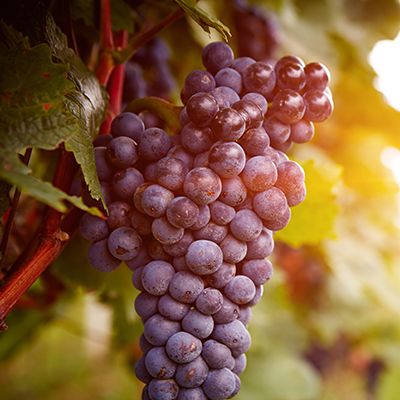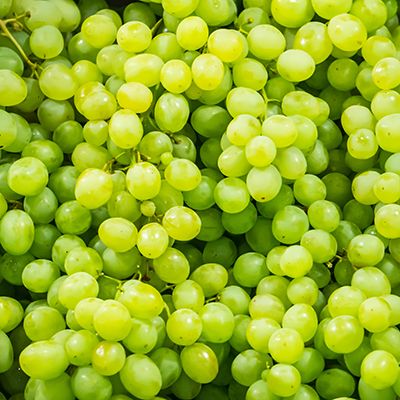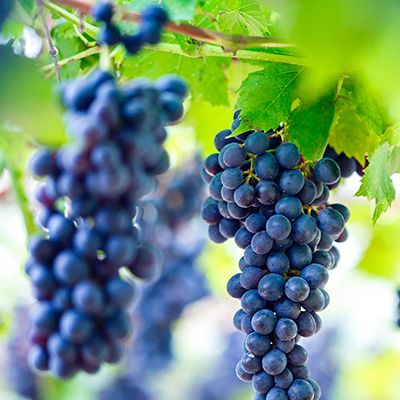


Grapes
Two major types of grapes; American and European, are available to home gardeners. A third group is the hybrids which are crosses of popular grape varieties.
American grapes (Vitis labrusca) are slip-skin grapes where the pulp slides easily out of the skin which is usually discarded. These grapes contain seeds, are very cold hardy and disease resistant. The Concord grape is the classic example of a slip-skin grape.
European grapes (Vitis vinifera) are less hardy than American grapes and have a defined heat requirement preferring a long, warm growing season. Their fruit is firm with nonslip skin and a relatively mild flavor. Some are seedless. Two examples are Himrod and Suffolk Red grapes. Most table grapes and wine grapes are European.
Grapes are adapted to a wide range of soil types as long as the soil is well drained. Grapes send their roots deep where they can and they prefer a soil that is rich in organic material. Growth can be encouraged by adding a 30% mixture of an organic supplement such as Gold Rush at planting time and mulching the roots afterward. In our heavy clay soils, dig a three foot diameter hole only deep enough to cover the top most roots with one inch of soil. Cut the roots of the new grape vine to fit the hole and straighten any curling roots. Backfill the hole around the grape vine with the amended soil mix and press firmly into place. Water thoroughly.
Grapes may not need fertilizer applications. If vines are not growing vigorously or show poor foliage color, they will respond to one pound of Master Nursery Fruit Tree and Vine Food per vine, applied twice a year; Memorial Day and right after harvest. Broadcast the fertilizer on the soil surface around the vine but not next to the trunk.
Grapes planted in deep soils in moderately warm to hot regions usually need one to three irrigations each season. On very shallow soils, water may be required as often as every two weeks. In the cool coastal areas, grapes are rarely watered but may benefit from early summer irrigation. Newly planted bare root vines should be watered weekly or biweekly until established.
The most common pests of the grape are mildew, aphids and leafhoppers. To control mildew which can cause leaf curling, withering of leaves and loss of fruit, spray the vines with sulfur when the shoots are 12 to 15 inches long. Thereafter, spray the foliage every two weeks until all the grapes have been harvested. Malathion applied at the time of the third sulfur spray, just before bloom will control aphids and leafhoppers. If no leaf hoppers are present, aphids can be controlled by spraying with Horticultural soap as needed.
Grapes require full sun and adequate warm weather for the fruit to develop and ripen. Harvest the grapes by taste and appearance. Taste a grape near the tip of the bunch and if it is good, cut the bunch. Sometimes grapes never taste sweet, no matter how long you wait. This means you have planted the wrong variety or you need to move the plant to a hot spot against a south wall or into a west facing corner.
All grapes require heavy pruning to produce fruit. Grape vines may be trained to be spur pruned or cane pruned. Spur pruning may be least complicated for the home gardener as follows:
- Plant the rooted cutting with 2 or 3 buds above the soil – cover with mulch.
- First Growing Season: Leave the plant alone and let it grow a number of shoots.
- First Dormant Season: Choose best shoot and cut others off at base. Head the remaining shoot back to 3 or 4 strong buds.
- Second Growing Season: When new shoots are about 12 inches long, select the most vigorous and cut the others off at the trunk. Tie the selected shoot to a support (post). When this shoot reaches its branching point at arbor top or trellis wire, pinch off its top to force branching. Let two strong branches grow.
- Second Dormant Season: Cut away side shoots leaving only the trunk and two major branches which tie to the trellis wire or arbor top.
- Third Growing Season: Let the vine grow. Pinch tips of sprouts on trunk.
- Third Dormant Season: Remove all shoots from the vertical trunk. Select the strongest side shoots on the two horizontal branches, 6 to 10 inches apart and cut them back to 2 buds. Remove all of the weaker shoots between the selected strong, 2 bud side shoots. The 2 bud selected shoots are called spurs.
- Annually: Every dormant season, cut the strongest spur back to 2 buds and remove any weaker spurs. Each spur will have two shoots which produce fruit during the summer.
Among the grape vines available at Wegman's are:
Cabernet Sauvignon, California Concord, Chardonnay, Concord Seedless, Flame, Himrod Seedless, Muscat of Alexandria, Suffolk Red Seedless and Thompson Seedless.